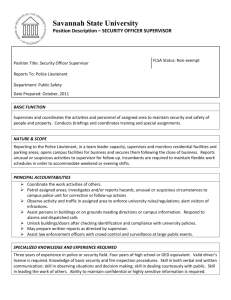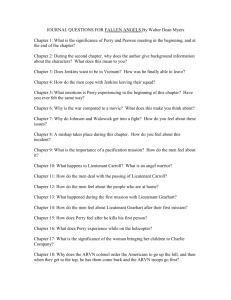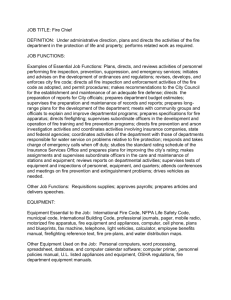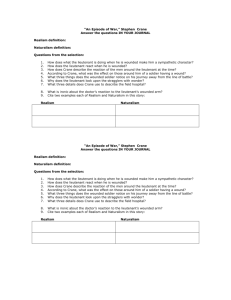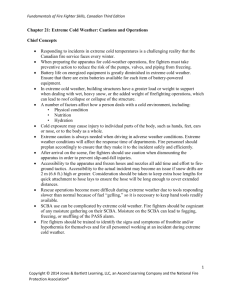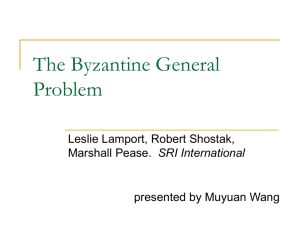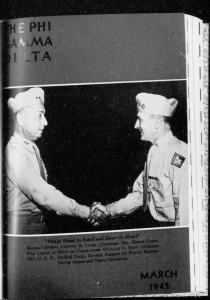Lieutenant - Northshore Fire Department
advertisement
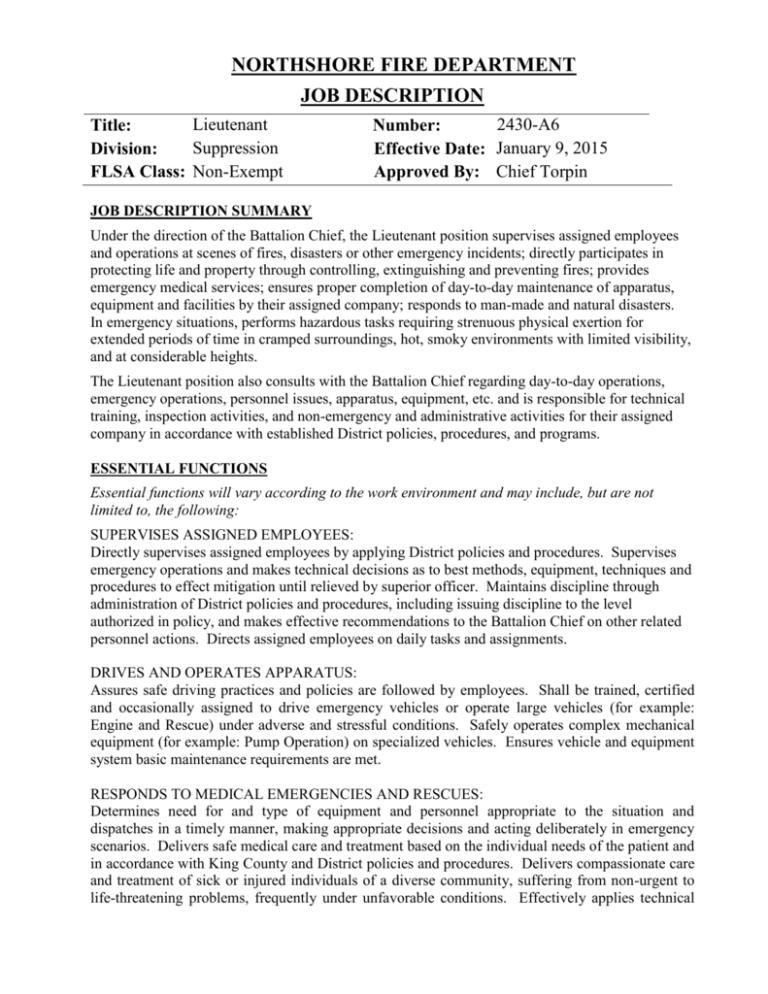
NORTHSHORE FIRE DEPARTMENT JOB DESCRIPTION Lieutenant Title: Suppression Division: FLSA Class: Non-Exempt 2430-A6 Number: Effective Date: January 9, 2015 Approved By: Chief Torpin JOB DESCRIPTION SUMMARY Under the direction of the Battalion Chief, the Lieutenant position supervises assigned employees and operations at scenes of fires, disasters or other emergency incidents; directly participates in protecting life and property through controlling, extinguishing and preventing fires; provides emergency medical services; ensures proper completion of day-to-day maintenance of apparatus, equipment and facilities by their assigned company; responds to man-made and natural disasters. In emergency situations, performs hazardous tasks requiring strenuous physical exertion for extended periods of time in cramped surroundings, hot, smoky environments with limited visibility, and at considerable heights. The Lieutenant position also consults with the Battalion Chief regarding day-to-day operations, emergency operations, personnel issues, apparatus, equipment, etc. and is responsible for technical training, inspection activities, and non-emergency and administrative activities for their assigned company in accordance with established District policies, procedures, and programs. ESSENTIAL FUNCTIONS Essential functions will vary according to the work environment and may include, but are not limited to, the following: SUPERVISES ASSIGNED EMPLOYEES: Directly supervises assigned employees by applying District policies and procedures. Supervises emergency operations and makes technical decisions as to best methods, equipment, techniques and procedures to effect mitigation until relieved by superior officer. Maintains discipline through administration of District policies and procedures, including issuing discipline to the level authorized in policy, and makes effective recommendations to the Battalion Chief on other related personnel actions. Directs assigned employees on daily tasks and assignments. DRIVES AND OPERATES APPARATUS: Assures safe driving practices and policies are followed by employees. Shall be trained, certified and occasionally assigned to drive emergency vehicles or operate large vehicles (for example: Engine and Rescue) under adverse and stressful conditions. Safely operates complex mechanical equipment (for example: Pump Operation) on specialized vehicles. Ensures vehicle and equipment system basic maintenance requirements are met. RESPONDS TO MEDICAL EMERGENCIES AND RESCUES: Determines need for and type of equipment and personnel appropriate to the situation and dispatches in a timely manner, making appropriate decisions and acting deliberately in emergency scenarios. Delivers safe medical care and treatment based on the individual needs of the patient and in accordance with King County and District policies and procedures. Delivers compassionate care and treatment of sick or injured individuals of a diverse community, suffering from non-urgent to life-threatening problems, frequently under unfavorable conditions. Effectively applies technical knowledge to complex problem assessment and solving to rescue persons or property, under diverse, and often stressful, circumstances. Activities will generally be limited to “operations” level; however, some personnel may be trained at a technician level and/or as an instructor. PERFORMS SUPPRESSION ACTIVITIES: Directs assigned employees and performs extremely strenuous physical work while wearing selfcontained breathing apparatus (SCBA), under some of the following conditions: Selects and deploys various hose lines and nozzles up to 5 inches in diameter to be used to direct water or chemicals onto fire; Carries, positions, climbs and works from ladders and other high areas under adverse conditions; Removes injured or incapacitated victims from danger and administer first aid as required; Uses power tools, and other mechanical equipment, to breech doors, walls roofs or floors, for various reasons; Communicates clearly and concisely using electronic devices and equipment. This includes the ability to do so while wearing personal protective equipment (PPE) and SCBA under adverse conditions such as high background noise, poor visibility, and drenching from hose lines and/or fixed protection systems (sprinklers); Assures employees work in a safe manner at all times, in accordance with state regulations and District policies and procedures. CONTINUOUSLY PARTICIPATES IN INITIAL AND ONGOING TRAINING: Prepares, conducts, and participates in training as required to meet District, State and federally recognized and accepted standards, which may include classroom instruction, creating lesson plans, practical and hands-on instruction, evaluations of assigned individuals or group, examinations and certification in a variety of areas, and physical fitness training. Remain current on fire service principles and practices. ACTIVELY PARTICIPATES IN FIRE PREVENTION / PUBLIC EDUCATION / PUBLIC RELATIONS ACTIVITIES: Following District policies and procedures, projects a professional public image. Coordinates and participates in public education and relations activities. Positively interacts with a diverse population, including children. Treats all persons respectfully, including fellow employees. Directs and participates in inspections of buildings/structures and other fire prevention activities as assigned. COMPLETES REPORTS AND RECORD KEEPING: Completes and processes forms, writes incident reports, completes daily log book and other documents. Accurately enters electronic data. KNOWLEDGE, SKILLS, ABILITIES Knowledge of: Current methods, principles, techniques and practices applied to firefighting, fire behavior, hydraulics, fire inspection, natural or man-made disasters, operation and maintenance of firefighting equipment and working knowledge of fire extinguishing systems, fire prevention methods and fire safety and related fields; Principles and practices of first aid including EMT training; Lieutenant 2430-A6 Traffic laws, ordinance and regulations involving equipment operation and extensive knowledge of Federal, State and District regulations, procedures and fire codes; Hazards of chemical properties of a variety of materials and ability to recognize environmental and workplace hazards, and implement safeguards to prevent accident or injury to employees or damage to District facilities and/or equipment; Current computer applications utilized by the District and utilize applications to perform and complete tasks and/or requirements of the job and ability to learn and apply new technologies and skills; Business letter writing, basic report preparation, and principles and procedures of record keeping; Modern office procedures, methods and equipment. Skill in: Effectively handle difficult or sensitive issues, using professionalism and an understanding of organizational culture; Interacting with others using tact, patience and courtesy; Using interpersonal and problem solving skills, including anticipating, analyzing, diagnosing and resolving problems; Using initiative and independent judgment within established guidelines; Delivering effective instructor-led training, both formal and informal, to various audiences and ability to effectively present information to moderate size groups. Ability to: Understand, interpret and apply documents such as operating instructions, applicable policies, procedures, fire codes, adopted ordinances and safety rules; Perform current EMS policies and procedures and their written location in effect in King County; Maintain confidentiality; Learn and possess working knowledge of geography and street locations of District response areas; Perform under considerable stress while confronted with emergency situations related to the job of a Lieutenant; Plan, assign, supervise, and review the work of assigned company; Maintain and establish effective and cooperative working relationships with District employees, public and public officials and to work effectively in a team environment; Adapt to changes in the work environment and to shifts in organizational philosophy and expectations; Conduct oneself in a professional manner as defined by District policy; Carry out special and general assignments requiring organization and development of procedures without direct supervision; Effectively present information to moderate size groups; Complete comprehensive work assignments and meet deadlines; Communicate in English clearly, concisely, and effectively, both orally and in writing; Add, subtract, multiply and divide in all units of measure, using whole numbers, common fractions, and decimals; Compute the friction loss and fire flows required for producing proper water flows during pumping operations. Lieutenant 2430-A6 SUPERVISORY RESPONSIBILITIES This position supervises assigned employees in training and at the scenes of fires, disasters, or other emergency incidents. EDUCATION/EXPERIENCE A high school diploma or equivalent is required; Associate degree in Fire Science or related field preferred. 5 years full-time firefighter experience including at least 2 years Fire Fighter III experience with the District. Upon promotion, Lieutenants must successfully complete the Officer Development Academy (ODA) as presented by King County Fire Training Officer’s Association; or a minimum of forty-five credits earned towards an approved Associate of Arts Degree program; or a combination of other fire service course work pre-approved by the District prior to the completion of their probationary period. CERTIFICATES AND LICENSES A valid Washington State Driver’s License is required. Washington State Emergency Medical Technician (EMT) certification is required. Fire Instructor I certification is required. PHYSICAL DEMANDS The physical demands described here are representative of those that must be met by an employee to successfully perform the essential functions of this job (includes functions as described in NFPA 1982). Reasonable accommodations may be made to enable individuals with disabilities to perform the essential functions. While performing the duties of this job, an employee is regularly required to talk and hear; use hands or fingers to handle and feel; seldom use of the telephone and computer; requires manual dexterity and visual acuity to operate firefighting equipment frequently and a computer or other standard office equipment seldom. Employee may sit occasionally but will also need mobility and ability to stand and walk continuously for long periods of time. This position will require the employee to perform strenuous work for extended periods of time, while performing some or all of the following: Wear a respirator (SCBA); Climb six (6) or more flights of stairs while wearing fire protective ensemble weighing at least 50 lbs. or more while carrying equipment/tools, typically weighing an additional 20lbs. to 40 lbs.; Perform expected duties while wearing fire protective ensemble that is encapsulating and insulated and will result in significant fluid loss that frequently progresses to clinical dehydration which can elevate core temperature to levels exceeding 102.2°F (39°C); Search, locate, rescue-drag, and carry victims ranging from newborn to adult weighing over 200 lbs. to safety despite hazardous conditions and low visibility; Work in unpredictable emergency situations for prolonged periods of physical exertion without benefit of warm-up, scheduled rest periods, meals, access to medication(s), or hydration; Lieutenant 2430-A6 Work in dark, confined, disorienting spaces; work in overheated environments; work under adverse and stressful conditions. WORK ENVIROMENT The work environment characteristics described here are representative of those an employee encounters while performing the essential functions of this job. The work area will encompass a wide variety of settings including: administrative duties in an office setting; regular exposure to outside weather conditions and could include emergency locations above or underground and in and/or around water, hazardous traffic areas and under unfavorable or unsanitary conditions which may include burning debris, falling structures, biohazards, air and blood-borne pathogens; confined spaces; commercial and residential structures, etc. Employees are regularly exposed to wet and humid conditions, fumes, airborne particles, toxic or caustic chemicals, extreme heat and risk of electrical shock. Employees may find themselves in hostile or psychologically demanding environments, involving emotional or psychological stress. The noise level in the work environment is usually moderate but may reach extremes where hearing protection is required. Work is usually performed during 24-hour shifts and work may be assigned to a standard 40-hour work week. SPECIAL REQUIREMENTS Requires ability to pass a pre-employment drug screening examination and any subsequent testing. Requires ability to pass a comprehensive background check. Employee must be insurable under the District’s existing vehicle and umbrella liability insurance carrier. Employee must meet the medical and physical requirements as specified in NFPA 1582, the Washington State Administrative Code, WAC 296 305 Safety Standards for Firefighters and WAC 296-842 Respirators. Lieutenant 2430-A6

